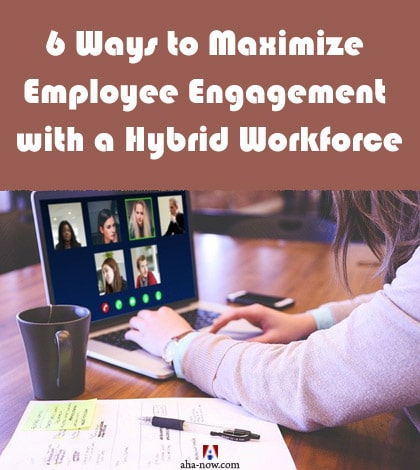6 Ways to Maximize Employee Engagement with a Hybrid Workforce in 2022
In pandemic times, employee engagement has become a challenge for the employers. Here are some tips for employers to enhance employee engagement programs.

The pandemic forced remote working on the employees. As the hybrid workforce continues even in the post-pandemic times, employee engagement has become a challenge for employers. Besides making work fun, employers can initiate discussion forums, incorporate real-time interaction platforms, use monitoring software to keep distractions and procrastination at bay, and much more to enhance employee engagement in their organizations. ~ Ed.

The global pandemic is proving to be a game-changer as far as remote working is concerned. Now, many employees opt for total remote or hybrid working out of preference even when rules permit the return to office workplaces.
There are lots of advantages to the employer. Hybrid working is flexible and attractive, helping to retain existing employees and attract new ones with a better work-life balance.
The global marketplace is available when it comes to looking for staff, and remote working can save vast amounts on the cost of office space.
However, hybrid or remote working is not without its challenges, and of these, one of the biggest is employee engagement.
Over time, some employees can feel marginalized or just unseen and unheard. It’s on HR departments and managers to replicate the collectivism of the former office environment, but that’s no mean feat.
Here are some proven ways to keep your staff engaged and motivated.
6 Tips to Improve Employee Engagement in Times of Remote Working
Use software to deal with distraction and procrastination, take regular feedback, help employees engage with one another, and much more.
Staff Training and Development
Write a performance or development plan for each staff member. This personalized progress plan is a tangible demonstration of their value to your organization. Nothing says ‘you matter’ more than employer input.
Tailor and implement educational and development goals with a range of new and exciting platforms that revolutionize old-fashioned passive and non-interactive training programs.
Learn to Win is a learning and performance platform that empowers your company to deliver fast and agile training to people in various locations with sharp, digital materials that are time-efficient and engaging.
There are considerable benefits to the business in connecting with employees in this way. It offers immense reach and defined results, and it’s a definite win-win.
Employee Inclusion
Initiate forums or discussions where every employee has the opportunity to make themselves heard. Giving input encourages a sense of inclusion and value and creates team spirit.
It’s essential that the workplace environment encourages free speech so that employees can air problems and differences. However, managers will need to manage these forums to prevent them from becoming harmful or destructive.
Use Good Software
One of the most significant issues with remote working, especially at home, is distraction and procrastination.
Home-working provides many challenges, and maintaining employee output is just one of them. Monitoring software helps with just that.
However, it is imperative that monitoring software is presented carefully and doesn’t give staff the impression that this is about pointing the finger or spying on them.
Monitoring software is a valuable tool to look at the output and assess where workload management could be better.
It’s crucial that staff come on board with performance management systems. Part of getting them to see its benefits is to present the software as a work assistant, helping them manage time productively.
There are many different software solutions to cope with the challenge of productivity and a remote workforce.
Many employees admit to the difficulties of constant distractions and the freefall effect of the home environment and welcome support.
These management systems aid focus and encourage output in a friendly and sustainable way that copes with the unique challenges of being at home.
Don’t overlook software that allows your employees to reach out to one another in a more relaxed way. These programs offer a space distinct from the daily business.
There are numerous examples of platforms that can keep people connected across different locations and time zones.
Think of it as the virtual break-out area or coffee machine.
Make Work Fun
Don’t mistake good employee engagement with work and nothing else.
Fun interactive sessions can help employees learn about one another and create the sort of banter you would experience face to face in an office environment.
Introduce fun sessions and games which are live and interactive. There are so many incredible ways to do this. Pick up on a trend or craze like Wordle, something everyone can join in with that creates a real buzz in the virtual office.
Helping employees to engage with one another on a more social level promotes that essential feeling of inclusion.
It also makes it easier for different people in disparate locations to collaborate on work issues and projects because they already have a social relationship.
Support Health and Wellbeing
Hybrid and remote work offer considerable advantages to employees, but it is a cultural change away from what they have previously known.
Employees’ mental health and wellbeing should rank as a higher priority when working remotely as it is more vulnerable, and it is harder to quantify when someone is struggling.
Face to face, it can be easy to spot a colleague who may be acting different from usual, who has become withdrawn, or who has changed their regular work routine. On a virtual basis, this is much harder to identify.
Regular feedback is the way to go via 1:1 meetings. Privacy is an essential element of workforce confidence that encourages staff to share their problems and challenges.
Make a point of checking in with everyone regularly, more frequently than if you were all together in one workspace.
Don’t Forget the Value of Face to Face
Don’t confine in-person time to the history books; it is still precious.
Meeting people face to face offers a unique perspective that you can’t tap into on a phone call or via a small screen.
Understand where the business would benefit from in-person and where it is okay to engage virtually.
Conclusion
Many people will not be returning to their everyday work practices as the global pandemic has instigated permanent changes in many people’s lives.
Homeworking is an attractive option once you get over the culture shock. There is no time wasted on the daily commute, saving costs and making it easier to juggle family life when there are issues like sick children.
It is unlikely that the workplace will return to what it was before. Still, hybrid and fully remote working are not a complete bed of roses and need careful employer management to deliver the best results for both parties.
Over to you
As an employer, what employee engagement strategies do you use? If you’re an employee, what are your experiences and expectations? Share in the comments below.
Disclaimer: Though the views expressed are of the author’s own, this article has been checked for its authenticity of information and resource links provided for a better and deeper understanding of the subject matter. However, you're suggested to make your diligent research and consult subject experts to decide what is best for you. If you spot any factual errors, spelling, or grammatical mistakes in the article, please report at [email protected] Thanks.

 ShanonG
ShanonG 
































